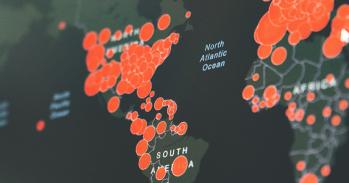
New research from Cambridge should help hospitals control the spread of MRSA and other emerging superbugs.
New research from Cambridge should help hospitals control the spread of MRSA and other emerging superbugs.
The fine scale discrimination that is now possible between two or more highly related MRSA strains means that it becomes possible to identify where strains have spread.
Dr Sharon Peacock
They have for the first time shown how transmission of the bacterial infection can be tracked between people in different continents and from patient to patient in a single hospital
They used new DNA sequencing technologies on samples taken from people with MRSA across the world.
The superbug killed a total of 2,823 people in 2007 and 2008 in the UK according to the Office for National Statistics. Annual deaths related to MRSA infection in the USA increased from 11,000 in 1999 to 17,000 in 2005.
One of the authors on the study, Dr Sharon Peacock, professor of clinical microbiology, said: "Until now it has not been possible to examine transmission of MRSA between countries and within and between healthcare institutions.
"The fine scale discrimination that is now possible between two or more highly related MRSA strains means that it becomes possible to identify where strains have spread and implement control measures to prevent this from happening."
The sequencing and data analysis were performed at the Wellcome Trust Sanger Institute and Dr Peacock was involved in clinical interpretation of the data, as well as considering the future application of the technology.
She added: "Our research should inform global surveillance strategies to track the spread of MRSA."
"The implications for public health are clear. This technology represents the potential to trace transmission pathways of MRSA more definitively so that interventions or treatments can be targeted with precision and according to need."
Two very different sets of samples were used. The first contained 42 samples from people throughout the globe who became infected with MRSA between 1982 and 2003.
The second set was from a single hospital in north-east Thailand and comprised 20 samples from patients who developed the infection within seven months of each other and which were possibly transmitted from person to person.
Dr Simon Harris, from the Wellcome Trust Sanger Institute, the co-lead author on the study, said: "We wanted to test whether our method could successfully zoom in and out to allow us to track infection on a global scale - from continent to continent, and also on the smallest scale - from person to person."
The team also developed an evolutionary tree of MRSA by looking at samples from hospitals in North and South America, Europe, Australia and Asia over more than 20 years. The research suggests that the infection emerged in the 1960s in Europe.
The new approach could also help future studies into the transmission and evolution of other bacteria.
The challenge now is to control infections by antibiotic-resistant bugs such as MRSA.
The research is published in this week's Science.
This work is licensed under a Creative Commons Licence. If you use this content on your site please link back to this page.





